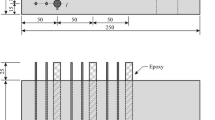Abstract
A sampling procedure, which avoids the need for wet cutting, has been developed for determination of compositional profiles of the pore liquid phase within concrete exposed to chloride ingress. The technique has been used to assess the effects on various concrete specimens of exposure to different regimes of chloride penetration and to compare them with those of salt, introduced as a constituent of the mix materials. The implications regarding corrosion risk to embedded steel are provisionally evaluated in terms of the ratio of chloride to hydroxyl ion concentrations in the pore solution. The significance of this parameter is to be considered in Part 2.
Resume
On exprime généralement en termes de contenu total de chlorure et de profondeur de carbonatation les critères qui déterminent le risque de corrosion dans le béton armé. On détermine par les procédures analytiques classiques la teneur totale en chlorure, et par les indications de pH telles que la phénolphtaléine, la profondeur de carbonatation. Ces méthodes sont imprécises du fait qu’une proportion variable de la teneur totale en chlorure peut exister sous forme insoluble comme celle de l’hydrate de chloroaluminate de calcium et que, d’autre part, le pH de l’électrolyte présent dans le béton que la phénolphtaléine indique comme étant alcalin, peut varier d’environ 10–14.
Afin d’obtenir une plus sûre indication du risque de corrosion à différentes profondeurs dans le béton exposé à des milieux riches en chlorures, on doit analyser la composition de l’électrolyte interstitielle en fonction de la distance de la surface exposée. Cet article, qui est le premier d’une étude en deux parties, décrit une approche expérimentale par laquelle on dispose d’échantillons de matériau avec solution interstitielle à différentes profondeurs dans des spécimens de béton exposés sans qu’on ait recours à un outil de coupe lubrifié. Cette technique appelée ‘crush-section’ élude par conséquent les risques potentiels de contamination de l’échantillon et de lessivage. On a procédé à une estimation des effets de l’exposition sur plusieurs types de béton à différents régimes de progression de sels. Les risques de corrosion en tant que fonction de la profondeur de pénétration et de la durée d’exposition sont provisoirement évalués en termes de variation des concentrations relatives de chlorure libre et d’ions hydroxyles dans la solution interstitielle.
Similar content being viewed by others
References
Page, C. L. and Treadaway, K. W. J., ‘Aspects of the electrochemistry of steel in concrete’,Nature 297 (5862) (1982) 109–115.
Hausmann, D. A., ‘Steel corrosion in concrete’,Mater. Protection 6 (November 1967) 19–23.
Gouda, V. K., ‘Corrosion and corrosion inhibition of reinforcing steel: 1. Immersed in alkaline solution’,Br. Corrosion J. 5 (1970) 198–203.
Page, C. L. and Lambert, P., ‘Analytical and electrochemical investigations of reinforcement corrosion’, TRRL Contractor Report CR 30 (Transport and Road Research Laboratory, 1986).
British Standards Institution, ‘The testing of hardened concrete’, BS 1881 (1983).
Longuet, P., Burglen, L. and Zelwer, A., ‘La phase liquide du ciment hydraté’,Rev. Matér. Constr. Trav. Publics 676 (1973) 35–41.
Tuutti, K., ‘Corrosion of steel in concrete’, Research Report FO 4 (Swedish Cement and Concrete Institute, Stockholm, 1982).
Sorensen, B. and Maahn, E., ‘Penetration rate of chloride in marine concrete structures’,Nordic Concr. Res. 1 (1982) 24.1–24.18.
Page, C. L. and Vennesland, O., ‘Pore solution composition and chloride binding capacity of silica-fume cement pastes’,Mater. Struct. 16 (1983) 19–25.
Holden, W. R., Page, C. L. and Short, N. R., ‘The influence of chlorides and sulphates on durability’, in ‘Corrosion of Reinforcement in Concrete Construction’, edited by A. P. Crane (Ellis Horwood, Chichester, 1983) pp. 143–150.
Andrade, C. and Page, C. L., ‘Pore solution chemistry and corrosion in hydrated cement systems containing chloride salts: a study of cation specific effects’,Br. Corrosion J. 21 (1) (1986) 49–53.
Page, C. L., Short, N. R. and Holden, W. R., ‘The influence of different cements on chloride-induced corrosion of steel in concrete’,Cement Concr. Res. 16 (1) (1986) 79–86.
Byfors, K., Hansson, C. M. and Tritthart, J., ‘Pore solution expression as a method to determine the influence of mineral additives on chloride binding’.ibid. 16 (5) (1986) 760–770.
Diamond, S., ‘Chloride concentrations in concrete pore solutions resulting from calcium and sodium chloride admixtures’.Cement Concr. Aggreg. 8 (2) (1986) 97–102.
Mangat, P. and Gurusamy, K., ‘Pore fluid composition under marine exposure of steel fibre reinforced concrete’,Cement Concr. Res. 17 (5) (1987) 734–742.
Kayyali, O. A. and Haque, M. N., ‘Chloride penetration and the ratio of Cl−/OH− in the pores of cement paste’.ibid. 18 (6) (1988) 895–901.
Vogel, A. I., ‘A Text-book of Quantitative Inorganic Analysis’, 4th Edn (Longman, Harlow, 1978) pp. 753–755.
Berman, H. A., ‘Determination of chloride in hardened portland cement paste, mortar and concrete’,J. Mater. 7 (1972) 330–335.
Wallbank, E. J., ‘The performance of concrete in bridges: a survey of 200 highway bridges’ (Department of Transport, HMSO, London, 1989).
Neville, A. M. and Brooks, J. J., ‘Concrete Technology’ (Longman, Harlow, 1987) pp. 101–108.
Crank, J., ‘The Mathematics of Diffusion’ (Oxford University Press, 1975).
Collepardi, M., Marcialis, A. and Turriziani, R., ‘Penetration of chloride ions into cement pastes and concretes’,J. Amer. Ceram. Soc. 55 (1972) 534–535.
Page, C. L., Short, N. R. and El Tarras, A., ‘Diffusion of chloride ions in hardened cement pastes’,Cement Concr. Res. 11 (1981) 395–406.
Roberts, M. H., ‘Effects of calcium chloride on the durability of pre-tensioned wire in prestressed concrete’,Mag. Concr. Res. 14 (42) (1962) 143–154.
Nixon, P. J., Page, C. L., Canham, I. and Bollinghaus, R., ‘Influence of sodium chloride on alkali-silica reaction’,Adv. Cement Res. 1 (2) (1988) 99–106.
Lambert, P., Page, C. L. and Vassie, P. R. W., ‘Investigations of reinforcement corrosion. 2. Electrochemical monitoring of steel in chloride-contaminated concrete’,Mater. Struct. in press.
Author information
Authors and Affiliations
Additional information
Crown Copyright. The views expressed in this paper are not necessarily those of the Department of Transport.
Rights and permissions
About this article
Cite this article
Page, C.L., Lambert, P. & Vassie, P.R.W. Investigations of reinforcement corrosion. 1. The pore electrolyte phase in chloride-contaminated concrete. Materials and Structures 24, 243–252 (1991). https://doi.org/10.1007/BF02472078
Issue Date:
DOI: https://doi.org/10.1007/BF02472078




